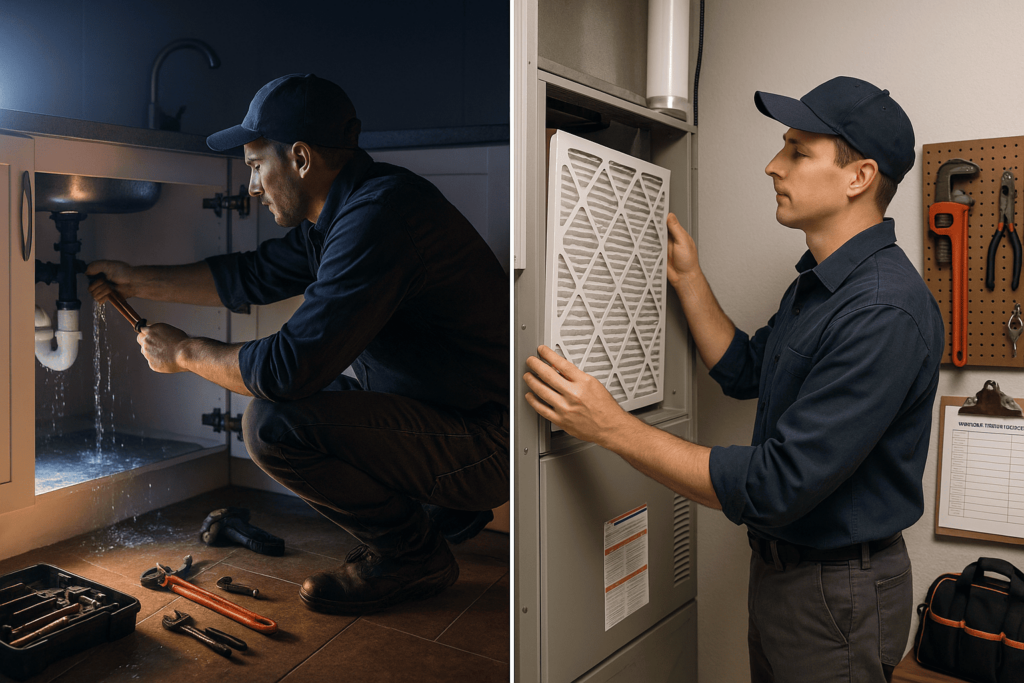
Emergency Repairs vs Maintenance: Landlord Responsibilities Explained Clearly
Landlords must understand the difference between emergency repairs and routine maintenance to manage properties effectively. Emergency repairs address urgent issues that threaten safety or habitability, such as gas leaks or broken heating systems. Routine maintenance involves regular upkeep to prevent problems, like cleaning gutters or servicing appliances.
Distinguishing these two categories helps landlords respond appropriately and prioritize repairs while fulfilling legal obligations. Knowing when an issue requires immediate action versus scheduled attention can impact tenant satisfaction and property value. This clarity also aids in budgeting and avoiding costly delays.
Defining Emergency Repairs and Maintenance
Distinguishing between emergency repairs and routine maintenance helps landlords prioritize actions and allocate resources effectively. Each type has specific characteristics related to urgency, impact, and necessary response times.
What Qualifies as Emergency Repairs
Emergency repairs address issues that threaten tenant safety, property integrity, or essential services. Examples include gas leaks, electrical failures posing fire risks, major water leaks or flooding, and broken heating systems in freezing conditions.
These repairs require immediate attention, often within hours, to prevent harm or further damage. Landlords must act quickly to arrange repairs and ensure the problem is contained or resolved.
Emergency repairs are typically unexpected and disrupt normal living conditions. Failure to address them promptly can lead to legal liabilities or health hazards.
Understanding Routine Maintenance
Routine maintenance involves planned, non-urgent tasks intended to preserve the property’s condition. This includes actions like HVAC filter changes, gutter cleaning, or fixing minor leaks.
Maintenance aims to prevent defects that could escalate into emergencies or costly repairs. Scheduling regular upkeep improves long-term property value and tenant satisfaction.
Tenants usually do not experience immediate danger or disruption with maintenance work. Response times are flexible, allowing landlords to coordinate repairs efficiently.
Key Differences and Overlaps
The main difference lies in urgency: emergency repairs demand quick fixes, while maintenance follows a scheduled timeline. Emergency work prevents immediate harm; maintenance avoids future problems.
Some issues may blur the lines, such as a leaking pipe that is not severe now but could worsen without timely repair. In these cases, landlords must judge based on risk and impact.
Comparison Table:
| Aspect | Emergency Repairs | Routine Maintenance |
| Urgency | Immediate (hours) | Scheduled (days/weeks) |
| Purpose | Prevent harm or damage | Preserve property condition |
| Examples | Gas leaks, flooding | HVAC checks, minor leaks |
| Tenant Impact | High (safety/disruption) |
Low (planned downtime) |
Landlord Responsibilities in Emergency Repairs
A landlord must act promptly when urgent issues arise to protect tenant safety and property. Responsibilities include understanding legal obligations, recognizing what qualifies as emergencies, and responding within appropriate timeframes.
Legal Duty to Respond
Landlords have a legal obligation to address emergency repairs quickly. Failures can lead to liability for damages or injury. Laws usually require a landlord to fix urgent problems that threaten safety, health, or the habitability of the rental unit.
Tenants must report emergencies immediately. Once informed, the landlord must act without unreasonable delay. Ignoring or postponing critical repairs can violate housing codes or lease agreements.
Emergency repairs typically cover issues like gas leaks, flooding, or electrical hazards. Landlords should be familiar with local regulations to comply fully.
Common Types of Emergencies
Typical emergencies include:
- Gas leaks
- Water leaks or flooding
- No heat during cold weather
- Electrical failures creating fire risk
- Sewage backups
- Broken locks affecting security
These situations require immediate attention due to potential dangers or property damage. Delayed responses can worsen conditions and raise safety risks.
Non-emergency repairs, such as cosmetic fixes or minor appliance malfunctions, usually fall outside this category.
Timeframes for Action
Landlords usually must respond within hours, not days, for emergency repairs. The exact timeframe varies by jurisdiction but often ranges between 24 to 48 hours from notification.
In life-threatening cases, such as gas leaks or fire hazards, landlords should respond immediately or arrange emergency services.
Documenting all communications and repair actions is crucial. This protects both landlord and tenant if disputes arise later about timeliness or adequacy of the repairs.
Landlord Obligations for Maintenance
Landlords must ensure rental properties are safe, habitable, and in good repair. This involves regularly checking property systems, quickly addressing tenant maintenance requests, and keeping detailed records of all activities related to upkeep.
Scheduled Preventive Maintenance
Landlords are responsible for routine inspections and maintenance to prevent breakdowns. This includes servicing heating, ventilation, and air conditioning (HVAC) systems, checking plumbing for leaks, and inspecting electrical wiring. Timely replacement of filters, cleaning gutters, and maintaining smoke detectors are also essential tasks.
Preventive maintenance helps avoid costly repairs and safety hazards. A schedule should be established based on the property’s age and system requirements. Failure to maintain these systems may lead to tenant complaints or legal liability.
Responding to Tenant Requests
Landlords must respond promptly to tenant maintenance requests. The typical expectation is to address urgent issues, such as water leaks or heating failures, within 24-48 hours. Non-urgent repairs should be scheduled and completed in a reasonable time frame, often within 7-14 days.
Communication is critical. Landlords should acknowledge requests, provide timelines, and update tenants on progress. Ignoring or delaying repairs can violate habitability laws and can lead to tenant retaliation or legal consequences.
Record-Keeping and Documentation
Accurate documentation of maintenance activities is essential. Landlords should keep logs of all inspections, repair requests, work orders, and invoices. This practice provides evidence of compliance with housing regulations and protections if disputes arise.
Records should include dates, descriptions of work performed, contractors’ details, and tenant communications. Digital tools or maintenance management software can improve record organization and retrieval. Proper documentation supports accountability and streamlines future maintenance planning.
Financial Implications for Landlords
Landlords face distinct financial responsibilities depending on whether repairs are classified as emergencies or routine maintenance. These classifications affect how costs are managed and the potential impact on insurance.
Cost Allocation Rules
Emergency repairs require immediate action to prevent damage or risk to tenants. Landlords must cover these costs directly, regardless of lease agreements. Failure to address emergencies promptly can lead to legal consequences and additional expenses.
Routine maintenance costs are generally planned and can be incorporated into operating budgets. Landlords may recover some expenses through rent or service charges if specified in the lease. Clear documentation of maintenance schedules helps manage cash flow and budgeting.
A table of typical cost responsibilities:
| Repair Type | Landlord Pays | Tenant Pays (if any) |
| Emergency Repairs | Always | Never |
| Routine Maintenance | Usually | Sometimes (if agreed) |
Insurance Considerations
Landlord insurance policies often differentiate coverage for emergency repairs versus routine maintenance. Emergency repairs linked to sudden damage, like pipe bursts, are usually covered under property damage clauses.
Routine maintenance issues, such as wear and tear, are typically excluded from insurance claims. Landlords should check policy specifics to understand which repairs qualify, ensuring proper budgeting.
Maintaining proper records of repair types and insurance claims can reduce disputes with insurers and speed up reimbursement processes.
Tenant Rights and Expectations
Tenants have specific rights aimed at ensuring their living conditions meet health and safety standards. They also have clear responsibilities when it comes to notifying landlords about issues that need repair.
Right to Safe and Habitable Housing
Tenants are legally entitled to housing free from hazards such as mold, broken heating, or unsafe electrical wiring. Landlords must maintain the property so it meets local housing codes and regulations.
This includes timely repairs for emergencies like water leaks or gas issues that pose immediate risks. Failure to provide safe conditions may allow tenants to request repairs directly or seek rent reductions.
Reporting Procedures
Tenants should report maintenance issues in writing to create a record. Written notifications typically include email, letters, or formal maintenance request forms.
For emergencies, tenants must inform landlords immediately by phone or in person. It’s important to document all communications and keep copies of requests and responses for potential disputes.
Legal Consequences of Non-Compliance
Failure to address emergency repairs or neglect routine maintenance can lead to serious consequences for landlords. These include financial penalties, legal liabilities, and formal dispute resolution procedures that can affect their reputation and income.
Penalties and Liabilities
Landlords who ignore emergency repairs may face fines imposed by local housing authorities. These fines vary by jurisdiction but can reach thousands of dollars per violation. For example, failure to fix gas leaks or severe plumbing issues promptly can result in immediate penalties.
Besides fines, landlords can be held liable for tenant injuries or property damage caused by negligence. Courts may require landlords to pay for medical expenses, damages, or even punitive damages if found grossly negligent. Additionally, tenants may withhold rent or terminate leases without penalty if repairs are not made timely.
Insurance policies may not cover damages arising from landlord neglect, increasing financial risk. Keeping accurate repair records can reduce exposure to liability and improve legal standing.
Dispute Resolution Process
When disputes arise over repairs, tenants often file complaints with housing agencies first. These agencies may issue orders requiring landlords to comply within a set timeframe. Failure to act can escalate enforcement actions, including court appearances.
Landlords and tenants may also resolve conflicts through mediation or arbitration. These processes are less formal, quicker, and less costly than court trials but still legally binding. Mediation encourages negotiation, while arbitration results in a binding decision made by a third party.
If disputes go to court, judges examine repair timeliness, landlord communication, and compliance with laws. Courts may order landlords to complete repairs immediately and pay damages or legal fees. Having documentation of maintenance efforts strengthens the landlord’s case.
Best Practices for Managing Repairs and Maintenance
Successful repair and maintenance management depends on clear communication and swift emergency response. Establishing consistent tenant interaction and well-defined emergency protocols ensures timely resolution and tenant satisfaction.
Effective Communication With Tenants
Landlords should provide tenants with clear guidelines on how to report issues, highlighting what constitutes emergency repairs versus routine maintenance. Using multiple channels such as email, text, or a dedicated portal helps streamline requests.
Regular updates about repair status build tenant trust. It is crucial to acknowledge receipt promptly and give approximate timelines. Providing a contact person for questions reduces confusion and prevents delays.
Documenting all communications helps track responsiveness and creates a record if disputes arise. Tenants value transparency on costs and next steps, so landlords should avoid vague responses.
Setting Up Emergency Response Protocols
Landlords must define what qualifies as an emergency, such as gas leaks, no heat in winter, or water damage threatening safety. Clear criteria reduce response time by avoiding unnecessary escalations.
A 24/7 availability system, whether through a property manager or third-party service, is essential. It ensures immediate action on issues outside regular hours.
Having trusted contractors on call accelerates repairs. Maintaining updated contact lists and service agreements avoids delays during urgent situations.
Regularly reviewing and updating protocols according to tenant feedback and past incidents helps improve efficiency and readiness.
Landlords must distinguish clearly between emergency repairs and routine maintenance. Emergency repairs require immediate attention to prevent harm or further property damage. Failure to act swiftly in emergencies can lead to legal and financial consequences.
Routine maintenance, however, involves regular upkeep to avoid emergencies and prolong property life. It is generally planned and budgeted for but remains essential to tenant safety and satisfaction.
Key differences include:
| Aspect | Emergency Repairs | Routine Maintenance |
| Response Time | Immediate | Scheduled |
| Purpose | Urgent safety or damage | Preventative care |
| Legal Obligation | Strict and often urgent | Ongoing responsibility |
Landlords who handle both appropriately create safer living environments. This reduces costly emergency situations and maintains property value. Understanding these roles strengthens landlord-tenant relationships and ensures legal compliance.
Trust Kanga Property Management to Navigate Repairs and Compliance with Confidence
Managing the balance between emergency repairs and routine maintenance isn’t just about fixing problems—it’s about protecting your investment, meeting legal obligations, and providing safe, habitable housing. With evolving regulations and tenant expectations, landlords need more than just timely repairs—they need a proactive, knowledgeable team ensuring nothing falls through the cracks.
At Kanga Property Management, we specialize in handling both urgent repair situations and preventive maintenance with efficiency, transparency, and full regulatory compliance. Our 24/7 emergency protocols, streamlined communication systems, and meticulous documentation practices make us the ideal partner for stress-free property ownership.
Choose Kanga for expert property management that prioritizes your legal protection, tenant satisfaction, and long-term property value.


